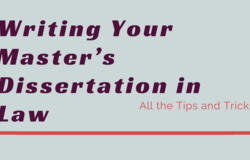Complete Guide On How to Write a Perfect Dissertation

Here’s the thing about dissertation writing. Ph.D. students have never written one before, they know that it is a huge undertaking, they begin with motivation, enthusiasm, and drive, and then can quickly lose that to a sense of drudgery, dread, and anxiety.
If you are just beginning, this guide will take you through topic selection to the very last sentence of your conclusion. If you are somewhere in between these two points, this dissertation writing guide will let you pick up where you are a bit stuck and carry you through. Each section covers one aspect/chapter of this project, explaining what must be included, how to organize it, and any tips that will make this lengthy process less stressful.
Step #1 - Choose interesting topic
If you have come this far in your Ph.D. studies, you already have one or two general topic areas that are of keen interest and that you are considering for your research project. No doubt, you have read what other researchers have done in the area. From this research and the suggestions that many of them have made for additional study, you will be able to identify a specific research question that you want to answer and that your advisor and committee will see as worthy of research.
The main points to pay attention to when wondering how to start a dissertation
- Do I want to replicate the research that has already been done in order to further confirm it?
- Do I want to add more to research so that some nuisance factor or limitation is accounted for?
- Do I want to strike out in a new direction with a question that no one has asked yet?
Any one of these three answers will give you a research question.
Checking in With Your Advisor: Some advisors can get pretty aggressive. They also have their “pet” studies and questions, and they have been known to try to steer their advisees in those directions. Be pleasant but be firm. If you are not interested in what your advisor suggests, politely decline. You are not writing a dissertation to please your advisor. You are doing this to contribute to your field of knowledge and to get your degree. Nothing will be more tortuous than to be researching a question in which you have little interest. If you are firm in your selected question, your advisor will respect that.
Step #2 - Write perfect proposal
If your research question has been of interest for any time at all, you will have read related research and have a good general idea of what has been done to date. This early research will be important as you draft the proposal that must be presented to and approved by your committee. While department specifications may vary in small ways, the structure of the dissertation proposal must include the following elements:
1. A Statement of the Research Question
Your research question will drive everything that you do. It must be stated in question form. For example, “Will a differentiated program for at-risk middle school students improve their academic and behavioral performance?” The specifics of that “differentiation” will be spelled out as you speak to existing research, and your methodology which will be presented later in the proposal.
2. Name the Objectives of Your Dissertation
Later on in the paper you will have to answer all of the questions and achieve the set goals.
3. Used Literature
This section will not include all of the literature that you will be reviewing for that chapter of your dissertation. But you should name the main works and authors you have used.
4. Summary of Existing Research
What you want to do here is briefly summarize (with citations of course) some of the major research studies you have read.
5. Dissertation Methodology
This you must get right. You are going to conduct some original research, and your design must be scholarly and appropriate for the research question you have chosen. Part of knowing how to write a dissertation is knowing how to justify the design you have chosen.
Your design will either be qualitative - collecting “hard” data that is then statistically analyzed and conclusions will be mathematically driven.
Or Qualitative Design gathers “soft” data – surveys, observations, and interviews for example. The data is still statistically analyzed, but there tend to be more nuisance factors in this type of research.
6. Potential Research Outcomes
Tell what outcome you expect after making a research. Explain your aims and reasons why your dissertation is important.
7. Timeline
Include a timeline for completion of each chapter. This is flexible of course and will change over the course of your project. Still, the committee wants to know that you have a plan.
Proposals tend not to be approved the first time through. Committee members all have their “pet” ideas and want to make suggestions. If you are running up against multiple “denials,” you may want to consult with a custom writing service – like OkDissertations - that has professional writers in your research area – for some help.
Step #3 - Dissertation Research Stage

On this stage you have to determine the way your project will develop. You may want to follow these steps:
- Stay commited to the timeline
Don't spend too much time on reading all the possible sources abouut the chosen topic. You have to demonstrate that you have conducted a thorough research but also understood the limitations of it.
- Find reliable sources
Not everything that can be found on internet is worth believing. You should always double-check all the information. Platforms like Google Scholar are quite a good place to find trustworthy sources and of course the actual libraries. Librarians can help you a lot if you ask, so don't ignore this option.
- Take notes
Your sources should be well-organised if you don't want to get confused and forget the source of a certain information. If you struggle with organization, another great resource is Docear. This site is a complete literature management system, from literature search (over 2,000,000 free pieces), metadata retrieval (over 10,000,000 in database), sorting of documents and notes into categories, and the ability to upload any other literature/documents (or mind map) you have. It is free, downloadable, and allows storage in the cloud for backup. You really should access this tool and see how it can keep you organized.
Step #4 - It's Time To Write Outstanding Dissertation
After completing all of the previous steps you can start working on the most important part. To make it much easier for you - make a plan. A lot of students start doubting their abilities at this stage and in order to keep working you should know exactly what to do.
Make a Dissertation Outline
- Introduction
Yes, this will be Chapter 1 of your work, but it should be written last. Why? Because once you have completed your study, have your results, and have written your conclusion, you are better prepared to write an introduction that will entice and engage.
You should include the following sections in your Introduction:
- State your research question clearly. You can really use the statement you prepared for your proposal.
- Give a brief explanation of the importance of the study that is being reported and explain what you hope to contribute to your field as a result of it.
- Describe the outcomes you are hoping to achieve
- Address your methodology briefly – very briefly.
Do not give away the story’s ending, but do give enough hints to intrigue. Read through introductions of other dissertations – you will get some good ideas for presentation.
- Literature Review
Your task is to locate the research that most relates to your question and to summarize it for the reader. You will begin by reading abstracts of other studies and selecting those that you believe will provide valuable research.
One of the things you should consider before you begin your synthesizing is mind-mapping. After you have read through your literature, you certainly have an idea of the categories of information/data you plan to include from that literature. If you want a great tool, try Mindmup – a very cool mind mapping tool that lets you create maps using any number of templates and save them as docs or PDF’s, then save, export or print them for use. The free version is all you will need. You’ll get your major points all organized before you begin to write.
- The Methodology Chapter
Here is your goal for this chapter. Can another researcher read it, understand exactly what you have done and actually replicate your study in his/her own research? You must describe in full detail exactly what you have done and justify it in a scholarly way.
The methodology chapter will have five sections, and your department may have a specified order in which they are written – check to be certain. Usually, however, the sections are as follows:
- The Design
What type of study – quantitative or qualitative? You have of course addressed this briefly in our introduction, but now is the time for detail. If a qualitative study, how did you go about selecting your random sampling? If a quantitative study, how did you set up your control and experimental groups. Did you used matched pairs? Or, did you only use an experimental group? State your independent and dependent variables.
- The Subjects/Participants and the Research Setting
Quantitative Study: Describe the setting of your research – a laboratory, geographical environment, etc. and the participants – animals, humans, aquatic plant life, etc. the important thing to remember is that another researcher must be able to replicate that setting. Be detailed but succinct.
Qualitative Study: You must determine the number of participants and justify that number. You can do this in a couple of ways. Use the alpha level power analysis, so that you achieve and 80% or better certainty that the desired effect will show up in your chosen sample. Or, you can replicate the sample sizes of prior researchers in related studies. Accurate and detailed description of the setting is crucial for qualitative studies.
- Instruments
You have two choices here. If you use existing instruments that have been previously validate, you will not have to do much more than describe them and explain how they were validated. If, on the other hand, you devise your own instruments, be prepared to justify why you selected the elements you did. This is especially important for qualitative studies, because the potential for nuisance factors is far more prevalent.
Instruments should always be included in an appendix.
- The Procedure
How did you gather your data? Be detailed.
For Qualitative Studies: For these studies, it is important that the instruments are delivered in exactly the same manner to all participants. Furthermore, you must be mindful of the permission forms that may very well be legally required, along with privacy and confidentiality guarantees.
For Quantitative Studies: You must explain in detail how, where, and when the data was gathered. For scientific studies involving plants and/or animals, for example, a full description of your procedure is not too challenging. If people in experimental and control groups are used, however, you must again gain permission.
- Processing the Data
This is also known as reporting the data you gathered. It has to be organized in formats that are easily read and understood – charts, graphs, etc. Fortunately, there are some great tools that will crunch the numbers for you. For some qualitative studies, the data may need to be collated and organized manually.
- The Results Analysis
Extremely important stage in the whole process, especially if you know how to write a good dissertation. You should perform the statistical analysis of the data using your best skills involved – mathematical, graphic design, and some great writing. Choose the correct formula, interpret the results, and then depict those results in a good graphical form with solid and scholarly prose explanations.
There are three “rules” as you compose this chapter:
- Every result you report as significant must relate directly to your research question.
- Every result you report must be based on some of the data you gathered and reported in the methodology chapter.
- If you get unrelated results, ignore them and do not report.
- Conclusion
This will not be a long chapter. Answer these questions.
- Have you answered your research question?
- Were there constraints and/or nuisance factors that you must account for? If so, how will you account for them?
- What contributions has your study made to your field?
- What recommendations do you have for researchers who will follow you? (note: don’t make any more than two recommendations. If you do, it will begin to look as if your study was not significant).
The best advice for this chapter? Read the conclusions of several other researchers and pattern your organization after theirs.
- Bibliography
This should now be a no-brainer. There are so many free tools, such as BibMe, that will automatically generate your citations according to the required format style. Your only task is to insert the information correctly.
- Write Your Draft
When everything is done, you should make a draft and check it for any mistakes, make sure the formatting and design is right and set it aside for a day or two. Then you should re-read it and evaluate it as objectively as it is possible. Show your draft to a professor and ask for advice. Only when your draft is perfect you can print a new copy of dissertation and hand it in.
Оrganize Dissertation Writing Process
Successfully completing a dissertation means that your physical and mental “environment’ is right for the next 12-18 months. So, there are other suggestions for you that are more general in nature, for before and during this huge project. Check out things to do before you start writing.
Hopefully, this guide can act as a solid resource as you go through this large chunk of your life. Keep your “eye on the prize,” stay organized, review what you need to do with each chapter, get help when you need it, and get that piece of parchment.
If you want your dissertation to be perfect - get assistance from our expert PhD writers. Order now and get a discount of 15%. Use code "15OFF".









